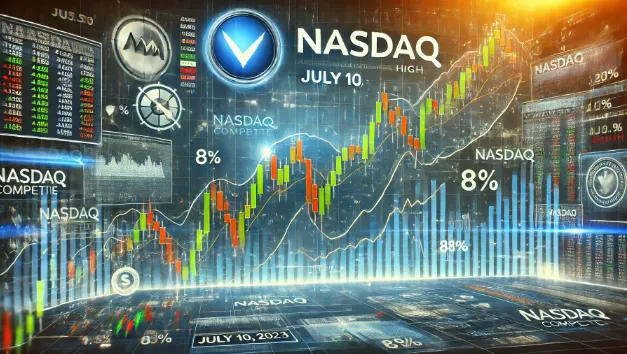
Tech loses its balance
Tech loses its balance
On July 10, the Nasdaq Composite hit a fresh, all-time high—one of many highs recorded this year. But after the 10th, the ride turned bumpy, and the tech-heavy index lost 8% over the next three weeks (Yahoo Finance, through July 30).
What weighed on tech?
A cooler-than-expected inflation reading in mid-July boosted rate-cut speculation.
However, the encouraging inflation figures and discussions about interest rate cuts did not lead to further advances in tech stocks. On the contrary, the opposite occurred.
Tech stocks experienced a sell-off as investors shifted away from this year's top performers, while the Russell 2000 Index, which represents smaller companies that had been struggling, experienced a sudden surge of 10.1% in July.
Smaller companies are more vulnerable to higher interest rates than larger firms and stand to disproportionately benefit if rates fall. Why?
Smaller firms have greater exposure to shorter-term floating-rate debt. Thirty percent of the debt of the Russell 2000 is floating rate, compared with 6% for the S&P 500, according to Goldman Sachs research from earlier this year (Wall Street Journal).
A July 31 story by MarketWatch pointed out that “the small-cap Russell 2000 has outperformed the Nasdaq Composite in July by 11.19 percentage points, on pace for its largest monthly outperformance since February 2001.
“Against the S&P 500, the small-cap index is poised for its best outperformance since February 2000.”
On the last day of the month, Fed Chief Jerome Powell explicitly said that a September rate cut is on the table.
Investors may also be questioning the significant amount of cash that’s being invested in AI and its eventual impact on profitability. However, unlike many firms that failed to survive the dot-com bubble, today’s tech giants are profitable.
Be that as it may, valuations may have gotten a bit extended, and the seemingly continuous rise in tech led to a detour of sorts in July.
Still, the Russell 2000 Index remains 7.7% below its all-time November 2021 high (Yahoo Finance), while the Dow, the S&P 500, and the Nasdaq have repeatedly set new highs this year.
As we enter August, investors are scrambling to see whether this is a short-term blip or if a sustainable rotation into the market laggards is underway.
Economic worries that entered the picture as August began injected volatility into all sectors, especially smaller-company stocks.
Calendar quirk
August and September have historically been unkind to investors, as they sport the two worst average monthly returns for the S&P 500 Index.
Since 1970, the average monthly return for the S&P 500 Index (excluding dividends) has been 0.09% during August and -0.96% in September, according to S&P 500 data provided by the St. Louis Federal Reserve.
Many have offered various reasons why August and September have historically underperformed, but few answers are truly satisfying.
Yet, I’d caution against attempting to time any historical seasonal trends that may or may not surface this year. Weakness in August is far from guaranteed. Since 2010, the S&P 500 in August rose in 2012, 2014, 2017, 2018, 2020, and 2021.
Instead, I recommend a diversified portfolio that helps mitigate market downturns but also keeps you positioned to participate in market upswings.
Your strategy should align with your financial goals, investment timeline, and risk tolerance. While I won’t discount the possibility of volatility over the next two months (for that matter, I’d never dismiss the possibility of a pullback in any season), I encourage you to keep your focus on your long-term financial goals.
I trust you have found this review to be informative. If you have any inquiries or wish to discuss other matters, please don’t hesitate to contact me.
As always, thank you for choosing me as your financial advisor. I am honored and humbled by your trust.

